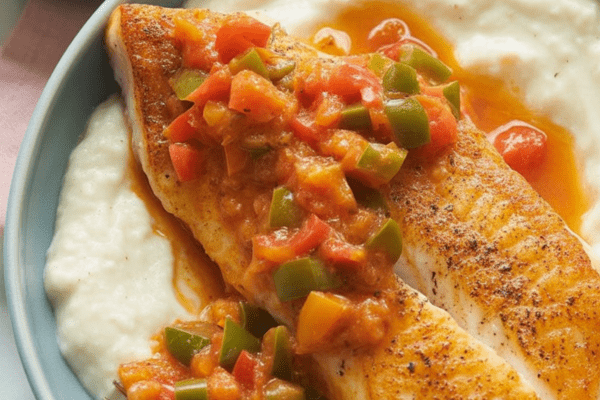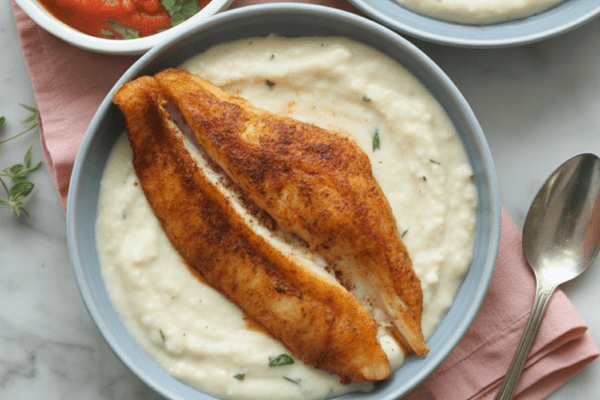If you’re looking for something hearty, comforting, and downright satisfying, this Southern-inspired fish and grits recipe is my kind of meal. Creamy, cheesy stone-ground grits topped with golden, pan-fried fish and a bold, spicy tomato sauce—it’s the sort of dish that warms you up from the inside out.

I especially love serving this on chilly evenings or weekend brunches when I want something special but familiar.
Why This Meal Hits the Spot
Growing up, grits were a staple in my family’s kitchen—simple, humble, and always there to soak up something delicious. But there’s something magical about pairing them with crisp, well-seasoned fish and a rich, tangy tomato sauce.
This dish is more than just comfort food. It’s filling, nourishing, and layered with flavor. The cheesy grits are creamy without being too heavy, the fish gets that perfect crispy edge in the pan, and the sauce is just spicy enough to make you sit up and take notice.
It’s one of those meals that feels both rustic and a little bit fancy—without too much work in the kitchen.
A Three-Part Southern Classic
What I really enjoy about this recipe is that it’s almost like three recipes in one. Each part—fish, sauce, and grits—can stand on its own, but when you bring them together, you get a plate that’s pure Southern soul.
For the Fish:
I go for catfish when I can find it—it’s classic, affordable, and takes seasoning beautifully. But any firm white fish will work. A simple seasoning rub and a good sear in butter or oil gives you a crisp crust with tender flesh inside.
For the Sauce:
This is where the magic happens. Tomatoes, bell peppers, garlic, and a bit of lemon for brightness. I like mine with a Southern-style spice mix that brings smoky, herby notes without drowning the fresh vegetable flavors.
For the Grits:
Forget the instant packets. Stone-ground grits are worth the extra time. Slow cooking them with milk, butter, and cheese gives you that creamy, lush texture you just can’t get any other way.
Ingredients and My Tips
For the Fish
- Catfish Fillets: I love catfish for its mild, sweet flavor. Cod, snapper, or grouper work beautifully too. Just look for a firm, flaky white fish.
- Seasoning: I usually use a homemade blend of blackened or Creole spices. Don’t be shy with it—this is where the fish gets its character.
- Butter or Oil: For frying. Butter gives a rich, nutty flavor, but olive oil is a lighter choice if you want it.
For the Sauce
- Bell Peppers: I like their subtle sweetness. They add color and a gentle crunch.
- Tomatoes: Fresh or canned both work. Fresh adds brightness, while canned gives a slightly richer base.
- Creole Seasoning: It’s the backbone of the sauce, full of herbs and a touch of heat.
- Chicken Broth: Adds body and savory depth.
For the Grits
- Stone-Ground Grits: Coarser and less processed than quick grits. They take longer but reward you with real flavor.
- Milk or Cream: For creaminess. I sometimes mix in a bit of broth for an extra savory note.
- Butter: A must for rich, silky texture.
- Sharp Cheddar Cheese: Adds a deeper, punchier cheese flavor than mild cheddar.

How I Cook the Fish
I start by patting the fish dry, brushing it with a little oil, and seasoning it generously on both sides.
A hot pan is key. I melt butter in a cast-iron or heavy skillet—there’s nothing like the sizzle as the fish hits the pan. I usually give it about 3-4 minutes per side, depending on thickness, until it’s golden brown and crispy on the outside, tender on the inside.
Once cooked, I set the fillets aside on a plate. You can tent them with foil to keep them warm while you make the sauce in the same pan.
Making the Tomato Sauce
I like to scrape up any browned bits from cooking the fish—that’s flavor you don’t want to waste. If there’s too much burnt residue, I’ll wipe the pan lightly but keep a little for depth.
A splash of oil goes in, then garlic, tomatoes, bell peppers, and green onions. I sauté them until they’re just softened.
Then I pour in chicken broth, a good squeeze of lemon juice, and Creole seasoning. I simmer it briefly so the flavors come together but keep the vegetables a little bit chunky and fresh.
Cooking the Creamy Grits
This part takes the most time but is mostly hands-off. I bring water, milk, salt, and a bay leaf to a gentle boil. Then I whisk in the stone-ground grits slowly, so they don’t clump.
After that, it’s all about patience. Low and slow cooking, stirring now and then, for about 40-45 minutes. I sometimes add a bit more hot water if they’re too thick.
Once they’re cooked, I remove the bay leaf and stir in butter and shredded sharp cheddar cheese until it’s melty and smooth. The smell alone makes me hungry every time.
Putting It All Together
When everything’s ready, I spoon a generous helping of creamy grits into shallow bowls. On top goes the crispy fish fillet, then a ladle of the warm, spicy tomato sauce.
I love serving this piping hot, with maybe a sprinkle of extra green onions or fresh herbs for color.
Personal Tips from My Kitchen
- Stone-ground grits take time, but the texture and flavor are worth it. Quick grits work in a pinch—just adjust cooking times.
- For crispier fish, you can dredge the fillets in seasoned flour or cornmeal before frying.
- Add chicken broth to the grits for extra savory depth.
- If your grits get too thick, thin them with a little milk or broth before serving.
- Don’t let cooked grits sit in the pot too long or they’ll stick. Wash the pot while it’s still warm for easy cleanup.
How I Store and Reheat Leftovers
If I’m planning ahead, I’ll make the grits and sauce the night before and just cook the fish fresh. That saves time in the morning for brunch.
For leftovers, I store everything separately in airtight containers.
- Fridge: Fish and sauce keep for about two days. Grits last up to four days.
- Freezer: Sauce and grits can freeze for three months; fish about a month.
- Reheating: Microwave works for quick single portions, but stovetop gives better texture. I warm the sauce and grits gently in separate pots, stirring often.
Common Questions
Can I use cornmeal instead of grits?
You can, but it’ll have a different texture. Grits are coarser and make a creamier dish.
What’s the difference between stone-ground and quick grits?
Stone-ground grits have better flavor and texture but take longer to cook. Quick grits are faster but more processed.
What do grits taste like?
They’re mild on their own but soak up whatever you add. With butter, cheese, and milk, they’re creamy and comforting.

Perfect Southern Sides
This dish is filling on its own, but if you’re feeding a crowd or just want to go all-out, add sides like collard greens, cornbread, sautéed green beans, or even a simple cucumber salad for a bit of crunch.
Honestly, there’s no wrong way to serve this. It’s Southern comfort on a plate, and I never get tired of making it.
Fish and Grits

Fish and Grits is one of those soul-warming meals that hits all the right notes—crispy, seasoned catfish over a bed of creamy, cheesy grits with a mildly spicy tomato-based sauce to tie it all together.
Ingredients
- oil, for brushing
- 1-1 ½ pound (454-680 g) catfish fillet
- salt and pepper, to taste
- 1-2 tablespoons (12-24 g) Blackened or Creole Seasoning (salt-free)
- butter or oil, for frying
- 2 teaspoons
- 1 tomato, diced
- ½ cup (75 g) red bell pepper, diced
- 1 green onion, thinly sliced
- ½ cup (125 ml) chicken or vegetable broth or stock, may add more
- 1 lemon, squeezed, about 2 tablespoon (optional)
- 1-2 teaspoons (4-8 g) Creole Seasoning
- salt and pepper, to taste
- 1 bay leaf
- 3½ cups (840 ml) water
- 1 cup (240 ml) milk, may be substituted with water
- salt, to taste
- 1 cup (140 g) stone-ground grits
- 3-4 tablespoons (42-56 g) unsalted butter
- 1-2 cups (113-226 g) white sharp cheddar cheese, preferably smoked
Instructions
- For the catfish, start by brushing the fillets lightly with oil and seasoning well with salt, pepper, and your choice of Creole or Blackened seasoning. Warm a large, heavy skillet over medium heat for a couple of minutes and add butter or oil, whichever you prefer. Once hot, lay in the catfish and cook for about 3-4 minutes per side, or until it reaches your ideal doneness. When cooked through, transfer it to a plate and set aside.
- If the skillet has any major burned bits, give it a quick wipe. Add a bit of oil back to the pan, then toss in the garlic, diced tomato, bell pepper, and green onion. Let everything sauté for about 2-3 minutes until softened and fragrant. Pour in the chicken or vegetable broth and a squeeze of lemon juice if you’re using it, then stir in the Creole Seasoning, adjusting salt and pepper to taste. Let the sauce simmer briefly so the flavors come together nicely.
- For the grits, combine the bay leaf, water, milk, and salt in a heavy-bottomed saucepan and bring to a boil. Slowly whisk in the grits a little at a time, making sure to keep stirring so you don’t get lumps. If lumps do start forming, take the pan off the heat for a moment to whisk them out. Once smooth, reduce the heat to a low simmer, cover, and cook for about 40 to 45 minutes, stirring frequently so it doesn’t stick. Add more boiling water if needed to maintain a creamy consistency. When the grits are thickened and cooked through, remove from heat and stir in butter and cheese until it’s melted and smooth.
- To serve, spoon a generous helping of the creamy grits into a shallow bowl, top with the perfectly pan-fried catfish and that rich, flavorful sauce. Enjoy it hot and hearty!
Notes
- If you’re using instant or quick grits instead of stone-ground, just keep in mind the cooking time will be much shorter.
- Try adding a cornmeal or flour coating to your fish if you want an extra crispy, crunchy texture. For an even richer flavor, you can swap out some of the water or milk in the grits for broth.
- If the grits seem too runny, let them sit for a bit and they’ll thicken up on their own. You can also drain any excess liquid, cook them a bit longer, or stir in a well-beaten egg to help firm them up.
- On the other hand, if they get too thick, just add a splash of water, milk, or broth to loosen them. Don’t leave the pot to sit too long after cooking because grits can really stick—wash it right away to make cleanup easier.
Nutrition Information
Yield
4Serving Size
1Amount Per Serving Calories 327Total Fat 27gSaturated Fat 13gTrans Fat 1gUnsaturated Fat 13gCholesterol 54mgSodium 2496mgCarbohydrates 15gFiber 2gSugar 3gProtein 7g
Easy Shrimp Recipes.com, occasionally offers nutritional information for recipes contained on this site. This information is provided as a courtesy and is an estimate only. This information comes from online calculators. Although allchickenrecipes.com attempts to provide accurate nutritional information, these figures are only estimates.

